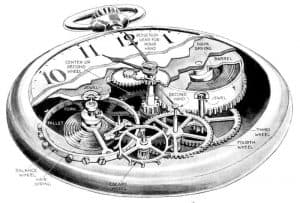An Important Key to Fulfillment and Happiness
A mother’s arms are made of tenderness, and children sleep soundly in them.
—Victor Hugo—
Key points: While men and women are equal, they are not identical. Flowing from this truth are two corollaries: First, a husband and wife likewise are equal, but not identical; and second, a dad and a mom, though equal, are not identical. These realities are not accidents, but true by divine design. Appreciating that design will help us go a long way in having and expressing appreciation for our mothers. Thank God for them!
Note: While this is a Mother’s Day post, the portion of the article that directly affirms and honors mothers is at the end. To fully appreciate mothers and the special contributions they make beyond but especially within the family, we need to understand and appreciate God’s design for the family. Be assured that exploring and learning about God’s design can only enhance our appreciation of our mothers. Keep reading!
This statement from Christian psychologist Peter Blitchington has intrigued me ever since I read it many years ago.
The strength of a nation can be fairly effectively gauged by the strength of its families, and the strength of a family can be estimated by the quality of its sexual roles.1
 It’s been forty years since Dr. Blitchington wrote these words. While his observation was counter-cultural then, today it flies even more thoroughly in the face of what society generally believes about sexuality and family life.
It’s been forty years since Dr. Blitchington wrote these words. While his observation was counter-cultural then, today it flies even more thoroughly in the face of what society generally believes about sexuality and family life.
Even so, it aligns beautifully with biblical teachings on men, women, husbands, wives, and the family structure. It also aligns with objective reality; accepting this truth on a national level and making personal adjustments to live in recognition of it will enhance societal stability. Although equal in value, men and women are not identical.2
Men are strong and independent and often are initiators. Women are intuitive, relational, patient, and supportive. This doesn’t mean that men can’t be relational or that women can’t ever lead. It does mean that, generally speaking, the husband is better suited to be the protector and provider of his family, and the wife is better equipped to be the nurturer and the source of warmth and encouragement in the home.

From Christian psychologist W. Peter Blitchington, we gain a great deal of insight into how male-female differences help foster emotionally healthy individuals and a healthy society—and how, from a Christian perspective, certain aspects of God’s image are reflected in each partner.

To Eve, and to women in general, God gave this important role—the ability to create new life; to deliver a unique human being, fashioned after his initial design. Woman represents the life-giving, nurturant side of God’s nature. Her capacity to give birth to a child represents God’s ability to give life to an entire universe. She represents God as the life-giver. The roundness and softness of woman were not designed just for the enjoyment of man alone (although that was part of the plan); they are also symbols of God’s tenderness and gentleness.…

But God didn’t stop there, for he is the life-sustainer as well as the life-giver. He could have made us without the capacity to create children after our own image; or he could have made us so that we give birth to independent, self-sufficient children who need no care or nurturance from their parents. But God chose to create us so that we would produce helpless, dependent children who needed our care and love in order to grow and develop. And so a woman’s breasts were created not to be mere ornaments but as life sustaining organs—reminders that every object in God’s creation is not made just to be selfishly admired and enjoyed (as important as beautiful things are), but to be used for others in some capacity. And appropriately, he placed those life-sustaining organs right over the heart of woman.

But the woman’s nature didn’t reflect God perfectly because it didn’t contain his power and strength, his initiatory activity and energy—in short, his masculinity.
So God created Adam—man—to reflect this side of God’s nature. He made Adam taller, more muscular, signifying the man’s role as the protector of his family. He was to be the first link in God’s chain of authority. God also created man to be more aggressive and dominant, more logical and analytical. All of these traits complemented the female traits perfectly. Adam submitted to God and Eve to Adam. All were in harmony. Since neither sex could fully represent God’s character alone, a unity between the two was required. Thus by his plan of marriage, God insured that there would be an opportunity for continual growth within the family.3

For those unfamiliar with the biblical story of creation (especially Genesis 2:7,15-25), a casual reading of the above paragraphs might leave readers with the impression God created Eve first, then Adam. Be assured Dr. Blitchington knows the creation story and merely was discussing the “feminine side” of things first. Perhaps he did so because it is only after God created the woman that we can understand how the man and woman complement each other with their differing innate strengths.
Let’s be sure we don’t overreact to the word submitted in the last paragraph we quoted from Dr. Blitchington, where he wrote, “Adam submitted to God and Eve to Adam.” According to Christian teaching, within the Godhead—God the Father, God the Son, and God the Holy Spirit—the Father is the decision-making member of the Trinity, or the initiator. For the Son and the Spirit to submit to the Father causes no strife or resentment. Thus, since marriage is to reflect the diversity and unity within the Godhead, the idea of submission ought not to create strife in a marriage.
Adam submitted to God and Eve to Adam. All were in harmony. Since neither sex could fully represent God’s character alone, a unity between the two was required. Thus by his plan of marriage, God insured that there would be an opportunity for continual growth within the family.
—W. Peter Blitchington—

Also in Christian teaching, marriage depicts Christ’s relationship with His bride, the church. Is it a burden for the church to submit to Christ, the One who laid down His life for her? Not at all! It is a joy to submit to Christ. Christ is Lord, but He doesn’t “lord it over” anyone. Similarly, since the husband is to love his wife as Christ loves the church and gave Himself for it, there should be no bitterness on the part of the wife as she responds positively to her husband’s leadership. Would any woman married to a man who truly loves her as Christ loved the church have difficulty responding positively to his leadership? How could she, unless she already has resolved to remain independent of him? Yet marriage is about unity and oneness, not individual independence.
God’s Design for Marriage Is Flawless
In a previous post titled “Flawless Design,” we talked about God’s design for marriage, the lifelong union of one man and one woman. We indicated that the marriage relationship as God established it in the beginning is rooted in His creation of men and women as both similar and different. Both are human beings God made in His image, yet each is different from the other in both obvious and subtle ways. Having created in Eve a helper for Adam who was comparable to or suitable for him, the two together were able to reflect God’s image more fully than either could alone.
A Christian man and his wife can together reflect God’s image more fully than either can alone.
A couple of disclaimers are important here. First, the fact that a Christian married couple can reflects God’s nature more fully than either the husband or wife can alone must not be seen as disparaging to the single adult who lives in service to God. Not at all. Paul was clear about how singleness can free and individual to accomplish great things for God. Second, while God’s design for marriage is perfect, no marriage is perfect, for marriages involve sinful individuals whose fallen nature will surely keep perfection at bay. Nevertheless, with a perfect design and a willingness to be shaped and matured by God, a couple can cooperate with God to bring their marriage to a place where it strongly reflects what God intended, and can and where it can accomplish His great purposes.
How does the divine design of the marriage relationship make a couple’s marriage work in practical terms? The husband and wife are like the parts of a mechanical watch.

-
- First, the parts fit together. Gear teeth interlock. Hubs hold wheels and gears in their proper places. Springs have the necessary space to be tightened and to loosen as the watch carries out its planned function. A husband and wife also fit together. We see this most obviously in the physical realm, but it is true on a multitude of other levels as well. In neither the watch nor in marriage are the players or parts identical, but they are compatible.
- Second, the parts work together to accomplish a positive purpose. Gears turn with other gears; springs tighten and then unwind slowly, and hands move because they perform their functions in harmony with all the other parts. Likewise, in a marriage as it was designed to function, a husband and his wife also work together. These beautiful words from Ecclesiastes 4 come to mind. While friendship is one context for these verses, marriage is the most fitting scenario. Note that verse 12 hints at God’s role in strengthening the couple’s covenant partnership.
- Third, as the parts work together, they also work against each other—not in an adversarial way, but in a way that enhances the function and role of each, as well as the overall performance of the larger item of which they are parts. How have we missed this? Because of the differences between components, each one is able to fulfill its role of pushing, prodding, nudging, and halting various other parts when actions like these are necessary. In marriage, we see this in that the husband and wife counterbalance each other when needed.
Children Need Both Fathers and Mothers
We see this in parenting as well; and here, on the verge of Mother’s Day, 2021, we need to savor the differences between men and women, husbands and wives, and especially mothers and fathers.
We need to affirm both fathers and mothers with renewed enthusiasm and with deep appreciation for God’s design. This is not to disparage single parents, dads and moms who do incredible work in rearing their children on their own; they need to be encouraged and affirmed, of course. But today, especially since we are just hours away from Mother’s Day, we need to see that moms are equipped to do important things dads simply are not equipped to do—and we need to affirm our mothers for doing them.
Today, especially since we are just hours away from Mother’s Day, we need to see that moms are equipped to do important things dads simply are not equipped to do—and we need to affirm our mothers for doing them.

Not many decades ago, people understood these things, even intuitively. Before Father Knows Best (FNB) was a television show, it was a regular radio program. Robert Young played the Father, Jim Anderson, on both radio and television. Be forewarned: If you get all bent out of shape about the title, you’ll miss out. FKB portrayed Jim Anderson’s flaws as well as his strengths.
On Thursday, May 18, 1950, an episode titled “Betty’s Screen Test” aired. It’s available for download here. Hear Robert Young’s tribute to mothers in the following one-minute, eight-second clip.
We can readily affirm that today, we would frame some of the statements made in this episode in ways different from how they were framed in 1950. In Robert Young’s tribute to mothers, for example, we wouldn’t use the world “plain.” But we know what Robert Young and Ed James, the writer of the script, meant; and we are foolish to get hung up over how Jim Anderson said what he said. His statement should be taken in its entirety.
We must never disparage the woman who chooses motherhood as being less important, or as doing less important work, than the woman who holds a career full time. Some mothers must work outside the home and be full-time mothers too, and they also deserve accolades.
The point here is that motherhood—and moms—need to be celebrated, affirmed, and supported. Don’t buy the lies of feminism and politically correct thinking.
Don’t allow them to silence you about the importance of motherhood, either. Study and appreciate God’s designs for marriage, the family, and society as a whole.
Also, honor your mother today, if she still is with you! Honor the mothers close to you as well.
And if you are a mother, know that you do the most important work in the world.
Copyright © 2021 by B. Nathaniel Sullivan. All rights reserved.
Unless otherwise indicated, Scripture passages have been taken from the New King James Version®. Copyright © 1982 by Thomas Nelson, Inc. Used by permission. All rights reserved.
Notes:
1W. Peter Blitchington, Sex Roles and the Christian Family, (Wheaton, IL: Tyndale, 1981), 13.
2The next several paragraphs of material have been adapted from portions of this article.
3Blitchington, 52.

Be First to Comment